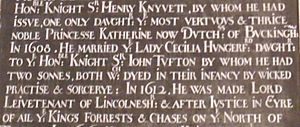Cecily Tufton Manners, Countess of Rutland facts for kids
Cecily Manners, Countess of Rutland (born Tufton; died 1653) was an important English noblewoman. She lived during a time of change in England.
Contents
Early Life and Marriages
Cecily Tufton was the daughter of Sir John Tufton and Catherine Browne. Her first husband was Sir Edward Hungerford. He passed away in 1607.
In 1608, Cecily married Francis Manners. He became the 6th Earl of Rutland in 1612. Francis's first wife, Frances Knyvet, had died a few years earlier. Letters from a family agent named Thomas Screven describe how Francis and Cecily met. He wrote that Francis was a very good suitor.
A Difficult Time for the Family
In 1615, the Countess of Rutland sought advice from a doctor and astrologer named Richard Napier. Later, in 1616, she consulted another physician, Henry Atkins. This was about the health of her young son, Francis, who was also known as the Baron de Ros.
Sadly, Cecily and her family faced a very difficult time. People believed that they were targeted by witchcraft at their home, Belvoir Castle. The deaths of her two children were blamed on the Flower family. Joan Flower and her daughters, Margaret and Philippa, worked as servants at the castle. They were accused of being witches and put on trial.
The Flower family confessed to making a special charm. They said it was meant to stop the Countess from having more children. A pamphlet was even printed in 1619 about these accusations. It was called The Wonderful Discovery of the Witchcrafts of Margaret and Philippa Flower. The pamphlet claimed that the Flower family had done some minor wrongdoings. It said they had taken groceries from the castle without permission. This story was also made into a popular song in 1619.
A Play for the Nobles
In 1621, a famous writer named Ben Jonson created a special play called The Gypsies Metamorphosed. This play was performed at grand estates like Belvoir Castle. During the play, an actor told Cecily's "fortune." This was a common form of entertainment for important guests.
Later Years and Legacy
The Countess was known to follow the Catholic faith. In 1626, she joined the household of Queen Henrietta Maria. She was allowed to attend religious services with the Queen.
Cecily Manners passed away in September 1653. She was laid to rest at Westminster Abbey, a very important church in London.
Her Portrait
There is a portrait of Cecily Tufton held by the Colchester and Ipswich Museums Service. Another full-length painting at Belvoir Castle was once thought to be of Francis Manners' first wife. However, experts now believe this painting, and another similar one, actually show Cecily Tufton Manners. She became the Countess of Rutland in 1612. In the painting, her left hand is tucked into a unique "geranium-red" Irish-style cloak.


